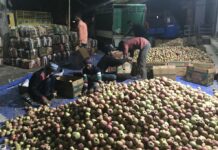Perhaps one of the costliest vegetables that are a powerhouse of vitamins and antioxidants, the Paarglass cultivation can boost the cash crop sector, reports Shafat Magray

They call it Paarglass. It is a highly nutritious vegetable growing around Gulmarg and is in huge demand throughout the world. It is asparagus. Most of the people and entire government are unaware of this vegetable that many think carried anti-carcinogens.
Mohammad Shaban Khanday, 75, a resident of Kalantra Baramulla started cultivating asparagus in 1985. This crop actually replaced his cherry fields. Deep into a bowl in hills, locally called Hapat Naar, he is cultivating this vegetable on two kanals of land. Shaban is still cultivating the vegetable and marketing it. But gradually he is getting lonely. The reason is the market.
“Earlier, we used to get better pricess Rs 13 for 12 pieces of asparagus rhizome root but now it costs only Rs 6 which is not enough,” one of Shaban’s family members said. “We lack transport facility to take the crop to Srinagar and there are lockouts which create problems.”
Shaban remembers his battle to grow the vegetable. “I hearkened about asparagus from my friend in Rajbag, and then I took seed from the Indian Institute of Integrated Medicine [IIIM] Sanatnagar and started growing it,” Shaban said.
Asparagus is a small slender vegetable, derived from the stem of asparagus plant. Only young shoots are eaten. It is a perennial crop.
“To grow asparagus it needs a fertile land whether plain or mountainous,” Shaban said. “Locally we use cow dung as a fertilizer for growing good quality plants”
One interesting thing about asparagus is that it is sown once and then it grows shoots for 15 years or more.
The fleshy green spears of asparagus are both succulent and tender and are considered a delicacy since ancient times. This highly prized vegetable arrives with the coming of spring when its shoots break through the soil. In Kashmir, it grows between April and July.
Shaban said his family consumes the delicacy and sells it too. It is also being fed to patients, who cannot swallow food. They use it steamed.
It is a delicate vegetable. It is being marketed in boxes. Though every shoot is almost 6 inches long, part of it is cut before it is boiled. People usually add salt at the time of boiling. It is only after this process is complete that the vegetable is being packed and exported outside Kashmir. The commercial boiling takes place in Srinagar only.
The vegetable is in demand in Europe and US because it is an excellent source of foliate that lowers the risk of cancers in colon, pancreas, and esophagus. Besides, it is vitamin C and beta-carotene rich food with huge anti-oxidants. It also contains the Saponins, known for their anti-inflammatory effect.
Ghulam Qadir Ganaie, 75, lives in Danmoo village brought seeds from Suntop Products Rajbag, Srinagar in 1980. “We all earned good money but due to unavailability of transport and low price we discontinued its cultivation,” says Qadir. “If Government pays some attention towards it, we will resume its cultivation. We only need crop insurance and adequate transportation to Srinagar market.”
“We have effectively stopped commercial cultivation but we still grow it for our own requirements,” Mohammad Rajab said. “We use it as a remedy for joint pains. It is very effective in these cases.”
Zahid Ahmad Harcho, 45, the promoter of Suntop Products, Rajbag is the only dealer in asparagus. Started in 1936, they are into this business for the third generation. “Its demand is like mushrooms,” Zahid said. “Now we have our own asparagus garden in Nowgam.”
But the bad news is that its production is declining almost at an alarming rate. The main reason is that accessing the remote belts is expensive.
“We are also selling Asparagus in Srinagar through Mahalotra Brothers, but not many people know.”
Sanaullah Wani, a Consultant at IIIM Yarikhah Tangmarg said they can provide people seed free of cost if they choose to cultivate the vegetable. Seeds are sown in February and then saplings are transplanted. The spears are cut well before it starts producing seed, farmers said.















